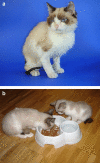Congenital hypothyroidism in a kitten resulting in decreased IGF-I concentration and abnormal liver function tests
- PMID: 20223692
- PMCID: PMC10822274
- DOI: 10.1016/j.jfms.2010.01.013
Congenital hypothyroidism in a kitten resulting in decreased IGF-I concentration and abnormal liver function tests
Abstract
A 7-month-old male kitten was presented with chronic constipation and retarded growth. Clinical examination revealed disproportional dwarfism with mild skeletal abnormalities and a palpable thyroid gland. The presumptive diagnosis of congenital hypothyroidism was confirmed by low serum total thyroxine (tT(4)) concentration prior to and after the administration of thyroid stimulation hormone (TSH), increased endogenous TSH concentration and abnormal thyroid scintigraphic scan. The kitten had abnormal liver function tests and decreased insulin-like growth factor 1 (IGF-1) concentration, both of which returned to normal in correspondence with an improvement of the clinical signs after 6 weeks of thyroxine therapy. Congenital hypothyroidism is a rare disease that may present with considerable variation in clinical manifestation. In cases in which clinical signs are ambiguous, disorders such as portosystemic shunt and hyposomatotropism have to be taken into account as differential diagnosis. As hypothyroidism may be associated with abnormal liver function tests and low IGF-1 concentrations, test results have to be interpreted carefully.
Copyright 2010 ISFM and AAFP. Published by Elsevier Ltd. All rights reserved.
Figures



Similar articles
-
Congenital hypothyroidism and concurrent renal insufficiency in a kitten.J S Afr Vet Assoc. 2014 Nov 14;85(1):1144. doi: 10.4102/jsava.v85i1.1144. J S Afr Vet Assoc. 2014. PMID: 25685940
-
Congenital Feline Hypothyroidism With Partially Erupted Adult Dentition in a 10-Month-Old Male Neutered Domestic Shorthair Cat: A Case Report.J Vet Dent. 2018 Sep;35(3):178-186. doi: 10.1177/0898756418785946. J Vet Dent. 2018. PMID: 30168381
-
Diagnosis of congenital and adult-onset hypothyroidism in cats.Clin Tech Small Anim Pract. 2006 Feb;21(1):40-4. doi: 10.1053/j.ctsap.2005.12.007. Clin Tech Small Anim Pract. 2006. PMID: 16584030 Review.
-
Medical Management of Dental Abnormalities Related to Congenital Hypothyroidism in a Cat.J Vet Dent. 2023 Sep;40(3):250-257. doi: 10.1177/08987564231161362. Epub 2023 Mar 14. J Vet Dent. 2023. PMID: 36916150
-
Congenital hypothyroidism of dogs and cats: a review.N Z Vet J. 2011 May;59(3):115-22. doi: 10.1080/00480169.2011.567964. N Z Vet J. 2011. PMID: 21541884 Review.
Cited by
-
Case Report: Human Recombinant Growth Hormone Therapy in a DSH Cat Presented With Dwarfism.Front Vet Sci. 2021 Nov 22;8:773355. doi: 10.3389/fvets.2021.773355. eCollection 2021. Front Vet Sci. 2021. PMID: 34881322 Free PMC article.
-
Primary hypothyroidism and thyroid goiter in an adult cat.J Vet Intern Med. 2014 Mar-Apr;28(2):682-6. doi: 10.1111/jvim.12283. Epub 2014 Jan 13. J Vet Intern Med. 2014. PMID: 24417675 Free PMC article. No abstract available.
-
Multiple pituitary hormone deficiencies in a kitten: Hyposomatotropism, hypothyroidism, central diabetes insipidus and hypogonadism.Can Vet J. 2023 Mar;64(3):245-251. Can Vet J. 2023. PMID: 36874542 Free PMC article.
-
Feline congenital hypothyroidism: a case report.Braz J Vet Med. 2023 Nov 10;45:e003423. doi: 10.29374/2527-2179.bjvm003423. eCollection 2023. Braz J Vet Med. 2023. PMID: 38024778 Free PMC article.
-
Evaluation of Weight Gain, Clinicopathological and Radiographic Changes after Early Diagnosis and Treatment of Congenital Hypothyroidism in Cats.Vet Sci. 2022 Mar 16;9(3):140. doi: 10.3390/vetsci9030140. Vet Sci. 2022. PMID: 35324868 Free PMC article.
References
-
- Stegeman J.R., Graham P.A., Hauptman J.G. Use of recombinant human thyroid-stimulating hormone for thyrotropin-stimulation testing of euthyroid cats, Am J Vet Res 64, 2003, 149–152. - PubMed
-
- Wakeling J., Smith K., Scase T., Kirkby R., Elliott J., Syme H. Subclinical hyperthyroidism in cats: a spontaneous model of subclinical toxic nodular goiter in humans?, Thyroid 17, 2007, 1201–1208. - PubMed
-
- Arnold U., Opitz M., Grosser I., Bader R., Eigenmann J.E. Goitrous hypothyroidism and dwarfism in a kitten, J Am Anim Hosp Assoc 20, 1984, 753–758.
-
- Peterson M.E. Feline hypothyroidism. Kirk R.W. Current veterinary therapy X (small animal practice), 1989, WB Saunders: Philadelphia, 1000–1001.
-
- Sjollema B.E., den Hartog M.T., de Vijlder J.J.M., van Dijk J.E., Rijnberk A. Congenital hypothyroidism in two cats due to defective organification: data suggesting loosely anchored thyroperoxidase, Acta Endocrinol 125, 1991, 435–440. - PubMed
Publication types
MeSH terms
Substances
LinkOut - more resources
Full Text Sources
Research Materials
Miscellaneous

